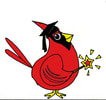|
|
|
Johann Sebastian Bach was a German composer and musician. He lived from 1685 to 1750, and the style of his music is called Baroque [bah-ROKE]. Bach was writing music in Germany at the time when the colonists and pilgrims were settling in our country. We’ll be studying some of the characteristics of Baroque music in our listening examples for this week.
|
Organs usually have two or more keyboards called "manuals". They also have a pedal board that is played with the feet. The pedal board is arranged just like the keys on the manual, with white and black keys. Pedals usually play the low notes, or the bass line. The black knobs on either side are called "stops", and they correspond to the different manuals. Pulling out certain stops cause pipes to produce different sounds, such as flutes, trumpets, oboes, strings, and the diapason, which is the true organ sound.
|
|
|
|
|
Bach was well-known as a virtuoso organist and music improviser. Improvisation is where a performer creates new music on an instrument without ever having played it before. Bach was famous for being able to sit down and improvise a fugue [fewg]. Fugues are one of the most complex and difficult forms in music. They became popular during the Baroque period and are still written today.
|
|
|
|
|
|
|
|
Bach composed a tremendous amount of music. His works for organ alone make up several volumes. Ironically, his music was not well known during his lifetime. It was not until about 100 years after his death that musicians began to take an interest in his works and appreciate the genius of his writing.
|
|
Bach excelled at using three important Baroque characteristics:
1) contrasting colors, 2) motion, and 3) filled space. Bach used these elements in what many consider the finest writing of the Baroque period, his Brandenburg Concertos [con-CHAIR-toes]. These were a set of six concertos written for a small orchestra of about 17 players. |
|
|
|
|
Bach was a deeply religious man. His church compositions started with the initials J. J., which stands for Jesu Juva [yeah-soo you-vah]. This means “Jesus, help”. At the end they were signed with the initials S. D. G., which stand for the Latin term Soli Deo Gloria, or “Glory to God alone”. Bach indicated that his work was produced for the sake of praising God.
|
|
Music written for church services is called sacred music. In Bach’s time, a popular form of sacred music was a cantata. Cantatas are written for choirs, solo singers and instruments. They last 25-30 minutes and have several sections, or movements in them. They might be based on a familiar hymn tune. Bach wrote new cantatas for each Sunday service as well as special ones for Christmas, Easter and weddings. In all, he wrote about 200.
|
|
|
|
